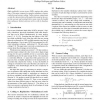Free Online Productivity Tools
i2Speak
i2Symbol
i2OCR
iTex2Img
iWeb2Print
iWeb2Shot
i2Type
iPdf2Split
iPdf2Merge
i2Bopomofo
i2Arabic
i2Style
i2Image
i2PDF
iLatex2Rtf
Sci2ools
IPTPS
2005
Springer
2005
Springer
High Availability in DHTs: Erasure Coding vs. Replication
High availability in peer-to-peer DHTs requires data redundancy. This paper compares two popular redundancy schemes: replication and erasure coding. Unlike previous comparisons, we take the characteristics of the nodes that comprise the overlay into account, and conclude that in some cases the benefits from coding are limited, and may not be worth its disadvantages.
| Added | 27 Jun 2010 |
| Updated | 27 Jun 2010 |
| Type | Conference |
| Year | 2005 |
| Where | IPTPS |
| Authors | Rodrigo Rodrigues, Barbara Liskov |
Comments (0)

